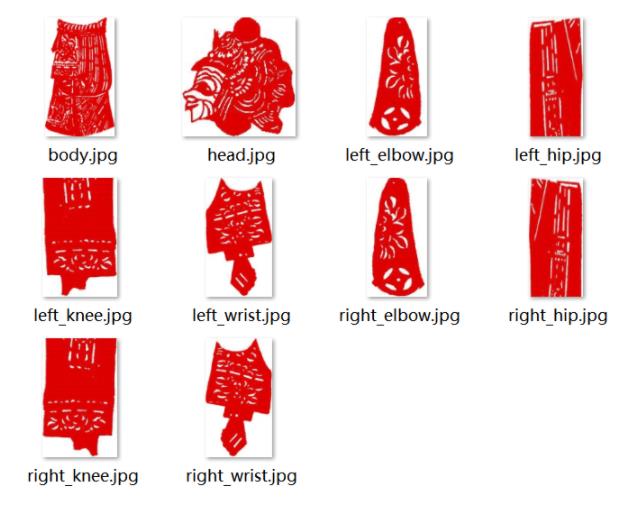使用飞桨Paddlehub实现皮影戏
Posted 我不学python
tags:
篇首语:本文由小常识网(cha138.com)小编为大家整理,主要介绍了使用飞桨Paddlehub实现皮影戏相关的知识,希望对你有一定的参考价值。
使用飞桨Paddlehub实现皮影戏
前言
飞桨(PaddlePaddle)是集深度学习核心框架、工具组件和服务平台为一体的技术先进、功能完备的开源深度学习平台,已被中国企业广泛使 用,深度契合企业应用需求,拥有活跃的开发者社区生态。提供丰富的官方支持模型集合,我们这里将要使用到其中的骨骼节点检测模型, 通过PaddleHub提供的人体骨骼关键点检测预训练模型,我们就可以快速实现皮影戏的效果。
PaddleHub可以便捷地获取PaddlePaddle生态下的预训练模型,完成模型的管理和一键预测。配合使用Fine-tune API,可以基于大规模预训练模型快速完成迁移学习,让预训练模型能更好地服务于用户特定场景的应用。

实现步骤
1、安装依赖包和模型
这里win+r再输入cmd可以进入windows命令行界面,输入以下代码可以快速安装
安装PaddlePaddle
python -m pip install paddlepaddle==2.0.2 -i https://mirror.baidu.com/pypi/simple
安装PaddleHub
pip install PaddleHub
安装人体骨骼关键节点检测模型:通过PaddleHub来安装人体骨骼关键点检测模型:human_pose_estimation_resnet50_mpii。
hub install human_pose_estimation_resnet50_mpii==1.1.1
2、测试是否成功以及拼接素材
本次使用的是pycharm,需要安装以下依赖库:cv2 4.5.1.48、matplotlib 3.0.3、numpy 1.16.2、tensorflow 2.4.1等。
检测是否安装成功
选取一张图片输入,若检测成功会检测到人体骨骼关键点信息
代码如下:
import os
import cv2
import paddlehub as hub
import matplotlib.pyplot as plt
from matplotlib.image import imread
import numpy as np
def show_img(img_path, size=8):
im = imread(img_path)
plt.figure(figsize=(size, size))
plt.axis("off")
plt.imshow(im)
def img_show_bgr(image, size=8):
image = cv2.cvtColor(image, cv2.COLOR_BGR2RGB)
plt.figure(figsize=(size, size))
plt.imshow(image)
plt.axis("off")
plt.show()
pose_estimation = hub.Module(name="human_pose_estimation_resnet50_mpii")
result = pose_estimation.keypoint_detection(paths=['test1.jpg'], visualization=True, output_dir="output_pose/")
print(result)

拼接皮影素材
拼接皮影戏需要素材,素材请到这个网址中下载,如文章第一张图那些:https://aistudio.baidu.com/aistudio/projectdetail/764130?fromQRCode=1&shared=1
代码如下:
import os
import cv2
import paddlehub as hub
import matplotlib.pyplot as plt
from matplotlib.image import imread
import numpy as np
def show_img(img_path, size=8):
'''
文件读取图片显示
'''
im = imread(img_path)
plt.figure(figsize=(size,size))
plt.axis("off")
plt.imshow(im)
def img_show_bgr(image,size=8):
'''
cv读取的图片显示
'''
image=cv2.cvtColor(image,cv2.COLOR_BGR2RGB)
plt.figure(figsize=(size,size))
plt.imshow(image)
plt.axis("off")
plt.show()
show_img('work/imgs/body01.jpg')
pose_estimation = hub.Module(name="human_pose_estimation_resnet50_mpii")
result = pose_estimation.keypoint_detection(paths=['test4.jpg'], visualization=True, output_dir="work/output_pose/")
print(result)
def get_true_angel(value):
'''
转转得到角度值
'''
return value/np.pi*180
def get_angle(x1, y1, x2, y2):
'''
计算旋转角度
'''
dx = abs(x1- x2)
dy = abs(y1- y2)
result_angele = 0
if x1 == x2:
if y1 > y2:
result_angele = 180
else:
if y1!=y2:
the_angle = int(get_true_angel(np.arctan(dx/dy)))
if x1 < x2:
if y1>y2:
result_angele = -(180 - the_angle)
elif y1<y2:
result_angele = -the_angle
elif y1==y2:
result_angele = -90
elif x1 > x2:
if y1>y2:
result_angele = 180 - the_angle
elif y1<y2:
result_angele = the_angle
elif y1==y2:
result_angele = 90
if result_angele<0:
result_angele = 360 + result_angele
return result_angele
def rotate_bound(image, angle, key_point_y):
'''
旋转图像,并取得关节点偏移量
'''
#获取图像的尺寸
(h,w) = image.shape[:2]
#旋转中心
(cx,cy) = (w/2,h/2)
# 关键点必须在中心的y轴上
(kx,ky) = cx, key_point_y
d = abs(ky - cy)
#设置旋转矩阵
M = cv2.getRotationMatrix2D((cx,cy), -angle, 1.0)
cos = np.abs(M[0,0])
sin = np.abs(M[0,1])
# 计算图像旋转后的新边界
nW = int((h*sin)+(w*cos))
nH = int((h*cos)+(w*sin))
# 计算旋转后的相对位移
move_x = nW/2 + np.sin(angle/180*np.pi)*d
move_y = nH/2 - np.cos(angle/180*np.pi)*d
# 调整旋转矩阵的移动距离(t_x, t_y)
M[0,2] += (nW/2) - cx
M[1,2] += (nH/2) - cy
return cv2.warpAffine(image,M,(nW,nH)), int(move_x), int(move_y)
def get_distences(x1, y1, x2, y2):
return ((x1-x2)**2 + (y1-y2)**2)**0.5
def append_img_by_sk_points(img, append_img_path, key_point_y, first_point, second_point, append_img_reset_width=None,
append_img_max_height_rate=1, middle_flip=False, append_img_max_height=None):
'''
将需要添加的肢体图片进行缩放
'''
append_image = cv2.imdecode(np.fromfile(append_img_path, dtype=np.uint8), cv2.IMREAD_UNCHANGED)
# 根据长度进行缩放
sk_height = int(get_distences(first_point[0], first_point[1], second_point[0], second_point[1])*append_img_max_height_rate)
# 缩放制约
if append_img_max_height:
sk_height = min(sk_height, append_img_max_height)
sk_width = int(sk_height/append_image.shape[0]*append_image.shape[1]) if append_img_reset_width is None else int(append_img_reset_width)
if sk_width <= 0:
sk_width = 1
if sk_height <= 0:
sk_height = 1
# 关键点映射
key_point_y_new = int(key_point_y/append_image.shape[0]*append_image.shape[1])
# 缩放图片
append_image = cv2.resize(append_image, (sk_width, sk_height))
img_height, img_width, _ = img.shape
# 是否根据骨骼节点位置在 图像中间的左右来控制是否进行 左右翻转图片
# 主要处理头部的翻转, 默认头部是朝左
if middle_flip:
middle_x = int(img_width/2)
if first_point[0] < middle_x and second_point[0] < middle_x:
append_image = cv2.flip(append_image, 1)
# 旋转角度
angle = get_angle(first_point[0], first_point[1], second_point[0], second_point[1])
append_image, move_x, move_y = rotate_bound(append_image, angle=angle, key_point_y=key_point_y_new)
app_img_height, app_img_width, _ = append_image.shape
zero_x = first_point[0] - move_x
zero_y = first_point[1] - move_y
(b, g, r) = cv2.split(append_image)
for i in range(0, r.shape[0]):
for j in range(0, r.shape[1]):
if 230>r[i][j]>200 and 0<=zero_y+i<img_height and 0<=zero_x+j<img_width:
img[zero_y+i][zero_x+j] = append_image[i][j]
return img
body_img_path_map =
"right_hip" : "./work/shadow_play_material/right_hip.jpg",
"right_knee" : "./work/shadow_play_material/right_knee.jpg",
"left_hip" : "./work/shadow_play_material/left_hip.jpg",
"left_knee" : "./work/shadow_play_material/left_knee.jpg",
"left_elbow" : "./work/shadow_play_material/left_elbow.jpg",
"left_wrist" : "./work/shadow_play_material/left_wrist.jpg",
"right_elbow" : "./work/shadow_play_material/right_elbow.jpg",
"right_wrist" : "./work/shadow_play_material/right_wrist.jpg",
"head" : "./work/shadow_play_material/head.jpg",
"body" : "./work/shadow_play_material/body.jpg"
def get_combine_img(img_path, pose_estimation=pose_estimation, body_img_path_map=body_img_path_map, backgroup_img_path= 'work/background.jpg'):
'''
识别图片中的关节点,并将皮影的肢体进行对应,最后与原图像拼接后输出
'''
result = pose_estimation.keypoint_detection(paths=[img_path])
image=cv2.imread(img_path)
# 背景图片
backgroup_image = cv2.imread(backgroup_img_path)
image_flag = cv2.resize(backgroup_image, (image.shape[1], image.shape[0]))
# 最小宽度
min_width = int(get_distences(result[0]['data']['head_top'][0], result[0]['data']['head_top'][1],
result[0]['data']['upper_neck'][0], result[0]['data']['upper_neck'][1])/3)
#右大腿
append_img_reset_width = max(int(get_distences(result[0]['data']['pelvis'][0], result[0]['data']['pelvis'][1],
result[0]['data']['left_hip'][0], result[0]['data']['right_hip'][1])*1.6), min_width)
image_flag = append_img_by_sk_points(image_flag, body_img_path_map['right_hip'], key_point_y=10, first_point=result[0]['data']['right_hip'],
second_point=result[0]['data']['right_knee'], append_img_reset_width=append_img_reset_width)
# 右小腿
append_img_reset_width = max(int(get_distences(result[0]['data']['pelvis'][0], result[0]['data']['pelvis'][1],
result[0]['data']['left_hip'][0], result[0]['data']['right_hip'][1])*1.5), min_width)
image_flag = append_img_by_sk_points(image_flag, body_img_path_map['right_knee'], key_point_y=10, first_point=result[0]['data']['right_knee'],
second_point=result[0]['data']['right_ankle'], append_img_reset_width=append_img_reset_width)
# 左大腿
append_img_reset_width = max(int(get_distences(result[0]['data']['pelvis'][0], result[0]['data']['pelvis'][1],
result[0]['data']['left_hip'][0], result[0]['data']['left_hip'][1])*1.6), min_width)
image_flag = append_img_by_sk_points(image_flag, body_img_path_map['left_hip'], key_point_y=0, first_point=result[0]['data']['left_hip'],
second_point=result[0]['data']['left_knee'], append_img_reset_width=append_img_reset_width)
# 左小腿
append_img_reset_width = max(int(get_distences(result[0]['data']['pelvis'][0], result[0]['data']['pelvis'][1],
result[0]['data']['left_hip'][0], result[0]['data']['left_hip'][1])*1.5), min_width)
image_flag = append_img_by_sk_points(image_flag, body_img_path_map['left_knee'], key_point_y=10, first_point=result[0]['data']['left_knee'],
second_point=result[0]['data']['left_ankle'], append_img_reset_width=append_img_reset_width)
# 右手臂
image_flag = append_img_by_sk_points(image_flag, body_img_path_map['left_elbow'], key_point_y=25, first_point=result[0]['data']['right_shoulder'],
second_point=result[0]['data']['right_elbow'], append_img_max_height_rate=1.2)
# 右手肘
append_img_max_height = int(get_distences(result[0]['data']['right_shoulder'][0], result[0]['data']['right_shoulder'][1]以上是关于使用飞桨Paddlehub实现皮影戏的主要内容,如果未能解决你的问题,请参考以下文章